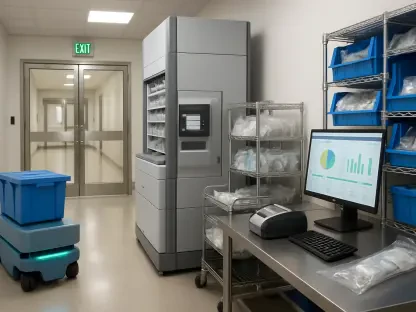In today’s fast-paced work environment, where hybrid and remote setups have become the norm, ensuring employee well-being has emerged as a critical challenge for organizations striving to maintain productivity and morale. Imagine a scenario where an employee wakes up feeling unwell, but instead of navigating traffic to reach a clinic or waiting hours for an appointment, they connect with a doctor through a virtual platform in minutes. This is the reality telehealth brings to the modern workplace, transforming how health concerns are addressed without disrupting daily responsibilities. By leveraging digital tools, companies are not only tackling the barriers of traditional healthcare access but also fostering a culture that prioritizes wellness. This shift is proving to be a game-changer, as it aligns with the evolving expectations of a tech-savvy workforce while offering tangible benefits to both employees and employers. The impact of such innovation on office dynamics is profound, paving the way for healthier, more engaged teams.
Transforming Workplace Health Dynamics
Accessibility as a Wellness Game-Changer
Telehealth has redefined what it means to access healthcare in a professional setting by eliminating the time and logistical barriers that often deter employees from seeking timely medical attention. With virtual consultations available at the tap of a screen, individuals can address health concerns without the need to take extended time off or endure the stress of commuting to a physical location. This immediacy not only helps in managing minor ailments before they escalate but also reduces the overall strain on employees who might otherwise push through illness to avoid disrupting work. The result is a workforce that feels supported in prioritizing health, leading to fewer sick days and a more consistent level of performance. Moreover, the ability to consult with healthcare providers from the comfort of one’s home or office space aligns perfectly with the flexibility that modern workers value, reinforcing a sense of autonomy over personal well-being.
Reducing Stress Through Seamless Care
Beyond mere accessibility, telehealth plays a pivotal role in alleviating the mental burden associated with managing health alongside work commitments. Employees often face anxiety over balancing doctor visits with deadlines, fearing that taking time for medical care might reflect poorly on their dedication. Virtual healthcare platforms mitigate this concern by offering discreet, efficient solutions that fit into busy schedules without drawing attention or requiring lengthy explanations. This seamless integration fosters a workplace environment where health is normalized as a priority rather than an interruption. Additionally, the reduced need for physical travel and waiting times means less disruption to daily routines, allowing employees to focus on recovery and return to their tasks with minimal delay. Such an approach not only enhances individual wellness but also contributes to a collective atmosphere of reduced tension and improved morale across teams.
Enhancing Organizational Efficiency and Culture
Streamlining HR Processes with Digital Solutions
One of the standout advantages of telehealth in the workplace lies in its ability to simplify administrative tasks related to employee health management. Digital records and medical notes generated through virtual consultations provide clear, verifiable documentation that supports HR policies on sick leave and ensures compliance with organizational protocols. This transparency helps prevent misunderstandings or potential disputes over absences, fostering trust between staff and management. Furthermore, the efficiency of having medical information readily available in a digital format saves significant time for HR departments, allowing them to focus on strategic initiatives rather than paperwork. By integrating telehealth into their systems, companies can maintain smoother operations while demonstrating a commitment to fairness and accountability in how health-related matters are handled, ultimately strengthening internal processes.
Building a Health-Focused Workplace Culture
Telehealth also serves as a powerful tool for cultivating a corporate culture that visibly values employee well-being, which can be a significant differentiator in attracting and retaining talent. When organizations adopt virtual healthcare solutions, it sends a clear message that health is a priority, resonating deeply with employees who seek employers aligned with their personal values. This cultural shift can enhance loyalty and engagement, as staff members feel genuinely cared for rather than treated as mere resources. Additionally, the presence of accessible health options can position a company as a forward-thinking entity in a competitive job market, appealing to prospective hires who prioritize work-life balance. Over time, this focus on wellness through digital means contributes to stronger team cohesion and a reputation for being an employer of choice, reflecting how investments in telehealth shape long-term organizational success.
Reflecting on Future Pathways for Wellness
Sustaining Momentum in Digital Health Adoption
Looking back, the integration of telehealth into workplace wellness strategies marked a turning point in how companies addressed employee health needs. As digital platforms became more entrenched, their role in reducing absenteeism and boosting productivity was undeniable. The next steps involve ensuring that these tools remain user-friendly and accessible to all employees, regardless of tech proficiency. Organizations should consider investing in training and support systems to maximize adoption rates, ensuring no one is left behind in the shift to virtual care. Additionally, staying updated with evolving telehealth technologies will be crucial to maintain relevance and effectiveness in meeting workforce expectations.
Prioritizing Long-Term Health Investments
Reflecting on the journey, it became evident that telehealth was more than a temporary solution; it laid the foundation for a resilient approach to employee wellness. Moving forward, companies should focus on partnering with telehealth providers to customize services that address specific workforce needs, from mental health support to chronic condition management. Encouraging regular feedback from employees about their experiences could guide refinements in these offerings. By committing to such proactive measures, businesses not only enhance individual well-being but also position themselves for sustained growth in an era where health and work are increasingly intertwined.









